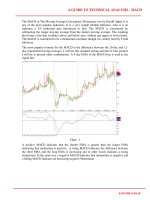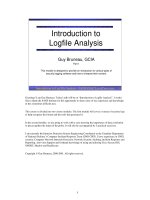Vol 4 introduction to technical analysis
Bạn đang xem bản rút gọn của tài liệu. Xem và tải ngay bản đầy đủ của tài liệu tại đây (18.53 MB, 77 trang )
INTRODUCTION TO
TECHNICAL ANALYSIS
Editor Matthew Carstens
WWW.INVESTING.COM
FOREX TRADING GUIDE
1
INDEX
The lnvesting.com.com education center was created in order to serve as a guide
to the novice trader over all the essential aspects of foreign exchange, in a fun and
easy-to-understand manner.
1. General Understanding
Basic Assumptions........................................................................................................ 4
The Necessity of Technical Analysis............................................................................... 5
Accessibility................................................................................................................... 5
2. Common Chart Types
Line Charts.................................................................................................................... 7
Bar Charts..................................................................................................................... 8
Candlestick Charts........................................................................................................ 9
Candlestick Patterns................................................................................................... 12
3. Trends and Ranges
Trading Trends............................................................................................................. 15
Trend Reversal............................................................................................................. 16
Trading Range............................................................................................................. 17
4. Chart Formations & Patterns
Symmetrical Triangles.................................................................................................. 18
Ascending Triangles..................................................................................................... 20
Descending Triangles................................................................................................... 22
Double Top.................................................................................................................. 24
Double Bottom............................................................................................................ 26
Head and Shoulders.................................................................................................... 28
Reverse Head & Shoulders.......................................................................................... 30
Chart Formation Highlights.......................................................................................... 31
5. Fibonacci
Fibonacci Retracements Illustrated.............................................................................. 35
2
INTRODUCTION TO TECHNICAL ANALYSIS
WWW.INVESTING.COM
Fibonacci Extensions................................................................................................... 40
Fibonacci Extension Price Targets................................................................................ 41
6. Moving Averages
Simple Moving Average (SMA)..................................................................................... 45
Exponential Moving Average (EMA).............................................................................. 47
7. Chart Indicators
Bollinger Bands........................................................................................................... 49
The Bollinger Bounce.................................................................................................. 50
The Bollinger Squeeze................................................................................................. 52
Moving Average Convergence/Divergence (MACD)..................................................... 54
MACD Crossover......................................................................................................... 56
Parabolic SAR............................................................................................................. 57
The use of Parabolic SAR............................................................................................ 58
Stochastic................................................................................................................... 58
Relative Strength Index (RSI)........................................................................................ 60
Utilizing the RSI........................................................................................................... 61
8. Elliott Wave Theory
The 5-3 Wave Pattern.................................................................................................. 64
Waves within Waves.................................................................................................... 67
9. Pivot Points
Pivot Breakout Trade................................................................................................... 71
10.Chart Time Frames
Long Term / Position Trader......................................................................................... 72
Short Term / Swing Trader........................................................................................... 72
Intraday / Day Trader................................................................................................... 73
Time Frame Chart Examples........................................................................................ 73
WWW.INVESTING.COM
INTRODUCTION TO TECHNICAL ANALYSIS
3
General Understanding
General Understanding
The Primary objective of this guide is to equip you with the prerequisite knowledge
needed when analyzing technical trends in the Forex market, and help educate you
about a number of the most popular technical trading tools which can help you
enhance your Forex investment decisions. technical Analysis uses past economic
data to forecast future price levels. Before trading in the markets, it is essential that
all Forex traders equip themselves with such knowledge.
Forex Analysis can be classified under two categories:
• Fundamental
• Technical
Fundamental Analysis
Forecasts price levels in the currency markets by analyzing economic and political data
and scenarios in an effort to predict which currency may gain strength or weakness
versus another over time.
Technical Analysis
Forecasts market trends usually with chart analysis to forecast price fluctuations in
different currency markets.
This guide will examine the principles of technical analysis and some of the tools that are
used for such analysis.
Basic Assumptions
Technical analysis is based on three main assumptions:
• In technical analysis, we are not necessarily focused on the reasons for any political
instability or the reasons for an economic crisis rather we are more interested in
watching how price levels change based on economic or political events, and then
how the price behaves relative to price levels of the past.
• Major currency rates have been shown to form noticeable patterns over time.
Technical analysis attempts to forecasts these patterns as a means to help set risk
parameters, or find profit opportunities for the trader.
4
INTRODUCTION TO TECHNICAL ANALYSIS
WWW.INVESTING.COM
General Understanding
• Technical Analysis can be very subjective as pattern recognition, wave counts,
overbought/oversold indicators or even trend lines are almost never agreed upon
as a whole. These tools should be used as a guide, or just one tool out of many, in
helping a trader make their trading decisions.
The Necessity of Technical Analysis
The majority of Forex traders nowadays rely a great deal on technical analysis and
fundamental analysis for formulating their trading strategies. The main advantage of
technical analysis over the fundamental analysis is that it can be used for diverse market
sectors and currencies simultaneously. Whereas fundamental analysis usually requires
complete comprehensive details about the political and economic scenario of a particular
country and as such traders will find it difficult to accumulate knowledge of more than a
handful of countries at a time.
Novice traders may initially be turned off by the complexity of technical analysis. However,
every long term successful trader understands the need of a trading strategy, and
Technical Analysis has proven to be a reliable tool for predicting price movements in Forex
to help formulate trading strategies for years. Nevertheless, it cannot be taken as 100%
correct as there are many factors which affect currency prices. It is for this reason that
most traders use an amalgamation of fundamental and technical analysis to help them
formulate their trading strategies.
Accessibility
All online Forex brokers should provide access to an extensive variety of technical analysis
charts. There are charting softwares which are free and also detailed professional charts
which require a monthly subscription. These charts are updated in real time and provide
several options for the user to view price movements and the different patterns that they
may form.
Your broker might provide these charts on their website or may include downloadable
charts as part of the trading software they provided to you.
Before venturing into live Forex trading, it would be wise to get familiar with market trends
by analyzing price changes and price levels using your charts for a while. You should try to
take note of their fluctuations and see if you notice any patterns developing. You can do
this through practice accounts which are usually provided by brokers for novice traders
to trade in with no real money transacted.
WWW.INVESTING.COM
INTRODUCTION TO TECHNICAL ANALYSIS
5
General Understanding
By using these practice accounts, you will be able to:
• Get acquainted with Forexcharts and market trends
• Familiarize yourself with the trading softwares which the broker uses.
6
INTRODUCTION TO TECHNICAL ANALYSIS
WWW.INVESTING.COM
Common Chart Types
Common Chart Types
Charts provide details about Forex price fluctuations during a specified period of
time. The specified time period can range from a minute to a few years. These prices
can be charted on simple line graphs or the price fluctuations can be depicted with
Bar charts or Candlestick charts.
Line Charts
Line charts provide you with an overall picture of the price fluctuation during a particular
period of time. Although they may not have the details which are shown in a Bar or
Candlestick charts, their simplicity makes them easy to read and to spot trends. They
are just depicted by a simple line connecting one market closing price to the subsequent
closing price.
Below is an example of a simple line chart where you can see price on the Y-axis and time
on the X-axis:
WWW.INVESTING.COM
INTRODUCTION TO TECHNICAL ANALYSIS
7
Common Chart Types
Bar Charts
Bar Charts provide you with much more details than the simple Line-Charts. The length
of the bar denotes the price spread (or movement) within a specific time period. If there
is a big difference between the high and low prices within that time period, this would be
indicated by a long bar. The opening price of this time period is denoted by the left tab
while the closing price is denoted by the right tab of the bar. Thus, you can immediately
see the direction of the price movement (up or down) as well as how much the price
moved within that time period. These charts depict the Open, High, Low and the Closing
price of the particular currency and as such they are also normally called OHLC chart.
An example of a price-bar is displayed in the figure below:
The figure below depicts an example of a bar chartwhere you can see price on the Y-axis
and time on the X-axis:
8
INTRODUCTION TO TECHNICAL ANALYSIS
WWW.INVESTING.COM
Common Chart Types
Candlestick Charts
Candlestick charts are a Japanese invention used for evaluating rice contracts. Candlestick
charts resemble bar charts in many ways as they also show the Open, High, Low and
Close prices of a specific period. Comparatively, they are far easier to read than bar-charts
as they form a wide body between the Open and Close price in a time period which can
be colored in to show upward or downward price movement by time period.
• Green or white color candlesticks depict increasing prices.
• Red or black color candlesticks depict decreasing prices.
WWW.INVESTING.COM
INTRODUCTION TO TECHNICAL ANALYSIS
9
Common Chart Types
In the example below where the body has been filled in with black, the opening price is
shown by the top of the body while the closing price is denoted by the bottom of the
body. This signifies that during this time period the price declined in value. If the body was
instead White then it means that the closing price is higher than the opening price and an
increase in value.
Corpo
reale
10
INTRODUCTION TO TECHNICAL ANALYSIS
WWW.INVESTING.COM
Common Chart Types
You will also hear of the term “wick”, which of course draws its name from a standard
candle wick you’d see on a birthday cake. The wick signifies the price range the asset
moved through during a period of time but did not open or close at (the Body).
It signfifies areas where buyers and sellers once battled at.
WWW.INVESTING.COM
INTRODUCTION TO TECHNICAL ANALYSIS
11
Common Chart Types
An example of a candlestick chart is shown below. Here “White” is represented by the
color Green while “Black” is represented by the color Red.
Candlestick Patterns
Candlesticks when seen in comparison with adjacent candlesticks may offer an indication
of possible market changes that can also assist in chart analysis. There is an entire
school of thought on the recognition and use of these, though they can offer insights on
continuation patterns and market reversals on a particular asset.
As noted above, the shapes of candlesticks are determined by the Open, High, Low, and
Close of a particular asset in a particular time frame. So within that time frame you are
actually able to witness the battle between both the buyers and sellers that can give you
clues as to what price action may happen next.
12
INTRODUCTION TO TECHNICAL ANALYSIS
WWW.INVESTING.COM
Common Chart Types
Here are a few examples of some popular ones, their fancy names, and how they are
most commonly used.
Engulfing
This pattern clearly shows that sellers (shown in Black) are in control in the time period on
the left but are not able to make any drastic moves (hence the small candle), then on the
next time period a much larger formation occurs where a bullish (shown in White) candle
completely “engulfs” the Black candle with its entire body. This is a very good indication
that Bulls are now in control and upward pricing pressure is probable. This pattern of
course works in the opposite way, where a Bearish candle engulfs a smaller Bullish one.
Hammer or Shooting Star
This pattern shows that buyers opened in this time frame near the high of the candle,
and for some reason lost a lot of ground as prices went down quite a bit thereafter.
Interestingly though, is that during this same time frame the buyers fought back and
actually closed higher than when they started. This is a very powerful signal that whatever
weight the sellers had has been used up as Bulls are clearly in control. This pattern also
works in the opposite direction where the body is at the bottom (Sellers win) and the line
(also known as the “Wick”) is above it.
WWW.INVESTING.COM
INTRODUCTION TO TECHNICAL ANALYSIS
13
Common Chart Types
Harami
The Harami draws a lot of similarities to the Engulfing patterns except whereas the
Engulfing Patterns shows a clear winner between Buyers and Sellers with momentum in
its favor, the Harami shows that the momentum is lost and there is still no clear winner
between the buyers and sellers. When this pattern is seen, price direction may be shifting,
or consolidation is occurring before another decisive move takes place. Caution should
be on your mind here.
Piercing or Dark Cloud Cover
This pattern shows how market sentiment can change quickly in just two time frames.
The candle on the left clearly shows bears in control and a lot of momentum. On the
next candle, the exact opposite occurs, even though the day opened lower than the
previous close. The day closed almost at the high of the previous day, showing that
bullish momentum is back in play. The Dark Cloud Cover pattern is shown when the
exact opposite occurs (Bulls have the momentum, but Bears open the day piercing the
previous time periods highs and closing much lower)
Doji
Probably the most famous pattern, because it is so easy to spot. The Doji clearly shows
a struggle between buyers and sellers closing at just about the same place it opened at
with wide ranges seen on the top and bottom of it. This pattern is very good at signaling
a reversal and can be seen at market tops and bottoms. Just be sure if you see one that
it isn’t due to market inactivity (low volatility)and that the Wicks have some length to them
on either side.
14
INTRODUCTION TO TECHNICAL ANALYSIS
WWW.INVESTING.COM
Trends and Ranges
Trends and Ranges
Once you have decided to trade in Forex, you have to learn some of the terminology
used in Forex Trading. This is critical as you need to understand what you are doing
before you can begin trading in Forex. the meaning of the terms used and their
implications are keys towards grasping a better understanding of the Forex market.
You need to be aware of the trading trends as well as the trading ranges before you
can formulate any trading strategies. This market requires technical knowledge,
and you must never trade it before learning important trading concepts. If you
choose to adopt this approach, what you will end up with eventually is an empty
pocket and a lot of frustrations. the correct way to go about venturing into this
market is to ensure that you have a firm understanding of what is happening in the
market. the only way in which this can be achieved is by educating yourself. there
is no shortcut.
Trading Trends
Trading trend is said to occur when the prices in the Forex market move constantly in one
particular direction. It is considered Bullish when prices are on the upswing and investors’
confidence is running high. The trend is regarded as Bearish when the fluctuations are on
the downswing. Whenever we are defining a trend, always keep in mind that the peaks
(highs) & troughs (lows) of prices are also moving in the same general “step” formation.
From this, you can draw support lines under an uptrend or resistant lines above a
downtrend. Once these lines have been breached, it is assumed that the trend has
completed its cycle and will start to reverse. Remember, that trend lines are subjective,
but do give you a good clue on general price levels for entry or stop loss decisions. Below
is an example of a diagram with an uptrend and downtrend with the support and resistant
lines drawn for you.
WWW.INVESTING.COM
INTRODUCTION TO TECHNICAL ANALYSIS
15
Trends and Ranges
Trend Reversal
Trend reversal simply means that the course of market prices is changing direction, or
that the “trading trend” has broken down, whereas in an uptrend prices noticeably failed
to make a new high, and are now breaching (or going through) what was once a price
support level. This failure clearly shows that something has changed and a reevaluation
needs to take place.
During this process there are a number of common chart formations that occur with
terms like “Double Top” (or Double Bottom), or even “Triple Top” (or Triple Bottom). Think
of a Double Top as a giant letter “M”, a Double Bottom them as a letter “W” (see the
two peaks or troughs in each?), and a Triple Top/Bottom as just adding another peak or
trough to each.
16
INTRODUCTION TO TECHNICAL ANALYSIS
WWW.INVESTING.COM
Trends and Ranges
Trading Range
Trading range essentially refers to a sideways chart pattern, or when prices are generally
consolidating and not making any noticeable moves upward or downward for an extended
period of time. Normally it is used to denote the latent period before a new trend starts,
also known as “building a base” or consolidation.
Understanding the current trend is very important for any investor, not only for their own
analysis but because so many other traders are looking at the same formations and
basing their decisions on it as well. In saying this, that adds a bit of crowd mentality
to trading which you can visualize through your charts and is why understanding chart
formations and spotting chart patterns are so important in understanding where prices
may, or may not, go in the future.
WWW.INVESTING.COM
INTRODUCTION TO TECHNICAL ANALYSIS
17
Chart Formations & Patterns
Chart Formations & Patterns
Chart patterns are useful for spotting breakouts before they occur which can assist
you not only in understanding future market trends, but also assist you with much
more specific price targets for your entry and exit positions.
The patterns covered in this topic include:
• Symmetrical Triangles
• Ascending Triangles
• Descending Triangles
• Double Top
• Double Bottom
• Head and Shoulders
• Reverse Head and Shoulders
Symmetrical Triangles
These triangles are chart formations in which the slope of the price’s peak and price’s low
converge at a point making it look like a triangle as illustrated in the chart below.
18
INTRODUCTION TO TECHNICAL ANALYSIS
WWW.INVESTING.COM
Chart Formations & Patterns
During this formation period, the market is experiencing lower “highs” and higher “lows”.
This essentially implies that neither buyers nor sellers are generating enough momentum
to push the price for a new trend. If we regarded this as battle between both buyers and
sellers, this would indicate a stalemate, for now. This is also known as consolidation
pattern.
With reference to the above chart (GBP/USD- April 2009), both the buyers and sellers
are not pushing the price toward either side. As this happens, the market is experiencing
lower “highs” and higher “lows”. Once these slopes converge, a “breakout” becomes
imminent. Although we do not know if the market is going to breakout on the low side or
high side, we definitely know that the breakout will happen and most likely volatility will
increase making for a strong move in either of the directions.
WWW.INVESTING.COM
INTRODUCTION TO TECHNICAL ANALYSIS
19
Chart Formations & Patterns
To take advantage of this, we either place entry orders above the lower “highs” slope (Buy
Stop to enter into a position) or below the lower “lows” slope (Sell Stop to enter into a
position). Since the breakout is imminent, we can capitalize on this information regardless
of the direction of the price movement.
Ascending Triangles
These formations occur when there is a slope of higher lows and a resistance level (usually
horizontal in nature). This is due to the fact that there is a price level in which buyers
cannot seem to breach. Nevertheless, they are gradually pushing the price up as shown
by the higher lows.
20
INTRODUCTION TO TECHNICAL ANALYSIS
WWW.INVESTING.COM
Chart Formations & Patterns
WWW.INVESTING.COM
INTRODUCTION TO TECHNICAL ANALYSIS
21
Chart Formations & Patterns
In the example above the resistance level was indeed broken and the price skyrocketed
upward.
Descending Triangles
As the name implies, these triangles are the opposite of ascending triangles. Here, there
is a succession of lower highs which constitute the upper line. The lower line represents
the support level which the price is having difficulty breaching.
22
INTRODUCTION TO TECHNICAL ANALYSIS
WWW.INVESTING.COM
Chart Formations & Patterns
In the EUR/USD- Dec 2008 chart above, you can observe that the price is slowly reaching
lower highs. This indicates that the sellers are gaining momentum against the buyers.
Again, generally speaking, this formation suggests that the support line will eventually be
breached and the decline in price will continue, however prudent traders should prepare
themselves if this does not occur.
WWW.INVESTING.COM
INTRODUCTION TO TECHNICAL ANALYSIS
23
Chart Formations & Patterns
In this scenario, the price was able to breach the support line and decline extremely fast.
Double Top
This is a reversal pattern which comes about after an extended move up. The tops are
price peaks which are the result of the price reaching a certain level that cannot be
breached. Upon reaching this level, the price bounces off the level slightly but rises again
in an effort to “test” that level again. If the price is pushed off again then what you get will
be a Double Top formation.
24
INTRODUCTION TO TECHNICAL ANALYSIS
WWW.INVESTING.COM
Chart Formations & Patterns
In the GBP/USD – Oct 2008 chart, you can observe the two tops after a strong rally
upwards. You can also observe that the second top is unable to reach the high of the
first top. This is a strong indication that a reversal is going to happen as buying pressure
is waning.
What we do in this case is to place our entry order just below the neckline in anticipation
of a downtrend.
WWW.INVESTING.COM
INTRODUCTION TO TECHNICAL ANALYSIS
25









